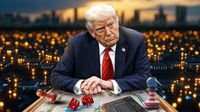High-ranking officials from the United States and China concluded the first day of a two-day trade negotiation on May 10, 2025, aimed at easing the trade war sparked by extensive tariffs imposed by former President Donald Trump. This development comes as China recently reported an increase in export figures for April, despite facing punitive measures from the U.S. Treasury Secretary Scott Bessen and U.S. Trade Representative Jamison Greer met with Chinese Vice Premier He Lifeng in what marked the first trade talks between the two largest economies since Trump set high tariffs on Chinese imports last month, prompting a strong retaliatory response from Beijing.
According to AFP, the discussions are expected to continue on May 11 in Switzerland. "The talks in Switzerland are an important step toward finding a solution to this issue," a source close to the negotiations said, although state media did not provide further details on the confidential discussions that began late Saturday at the Swiss ambassador's residence in Geneva.
Trump's tariffs, which have been in effect since the start of 2025, currently stand at 145%. However, when considering cumulative tariffs imposed by the U.S., the ceiling for certain imported goods from China reaches as high as 245%. In response, China has retaliated by imposing a 125% tariff on imports from the U.S., effectively creating a near-total trade blockade between the two nations.
On May 9, Trump hinted he might consider reducing the high tariffs on Chinese imports, suggesting via social media that "taxing China at 80% seems appropriate!" Meanwhile, U.S. Commerce Secretary Howard Lutonik stated in an interview with Fox News that "the President wants to work to find a solution with China; he wants to reduce tensions." However, any move to lower tariffs appears to be more symbolic, as the rates remain significantly high.
Bill Rench, a senior advisor from the Center for Strategic and International Studies (CSIS), commented, "The tax measures are a barrier to trade for both sides. The relationship is deteriorating, but this meeting is a positive sign." Similarly, Xu Pin, a professor of economics and finance at the China Europe International Business School (CEIBS), remarked, "I think at the very least it shows that both sides are talking, and that in itself is important, as China is the only country that has retaliated against Trump's tariffs tit-for-tat."
Bessen noted that the meeting in Switzerland will focus on de-escalating tensions rather than pursuing any major trade agreements. Beijing, however, insists that the U.S. must first lift the tariffs before any further discussions can take place, emphasizing the need to protect its own interests. A source quoted by Xinhua stated, "There will be no winners in the trade war and tax battle."
Despite the ongoing trade war, China's export figures showed a surprising increase of 8.1% in April compared to the same month last year, driven by a surge in shipments to Southeast Asian countries that helped offset declines in exports to the U.S. due to the tariffs. Customs data revealed that while exports to the U.S. fell by 21%, imports decreased by nearly 14%. In the first four months of this year, exports from China to the U.S. dropped by 2.5%, while imports fell by 4.7% compared to the previous year.
In related news, the U.S. Department of Commerce announced plans to replace the complex AI Diffusion Rule established during the Biden administration with simpler regulations aimed at fostering innovation and ensuring the U.S.'s AI leadership. The new framework, which is expected to be announced soon, will aim to streamline the export of advanced AI chips, such as those produced by Nvidia, Advanced Micro Devices, and Intel, to various countries without requiring licenses.
The AI Diffusion Rule, which was set to take effect on May 15, 2025, categorized countries into three tiers based on their level of restriction, from unlimited to highly restricted exports. The Trump administration's proposed changes will reportedly allow for more direct negotiations with countries regarding chip exports, potentially easing tensions with nations like the United Arab Emirates (UAE) and Saudi Arabia, which have expressed dissatisfaction with existing restrictions.
Despite these changes, the Trump administration is expected to maintain strict export controls on chips destined for China, which has been a focus since 2022. The new policy is seen as an opportunity for other countries to negotiate easier access to AI chips amid global efforts to develop domestic AI technologies. However, analysts caution that certain restrictions may still apply to countries with a history of transferring chips to China, such as Thailand and Malaysia, which serve as key transit points for chip assembly and distribution.
Moreover, reports suggest that Trump is considering establishing a "Global Licensing Regime" through government-to-government agreements to replace Biden's policy, which could lead to stricter regulations and complicate the compliance process for technology companies. This potential shift raises concerns about the impact on global supply chains, particularly in the AI and server industries, where critical equipment and infrastructure are sourced from various regions worldwide, especially China.
As the negotiations continue, both sides are keenly aware that the stakes are high. The outcome could reshape the future of trade relations between the U.S. and China, and potentially influence global markets as countries navigate the complexities of technology exports and international trade agreements.




